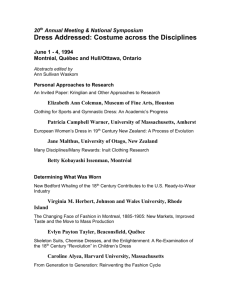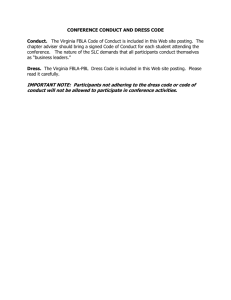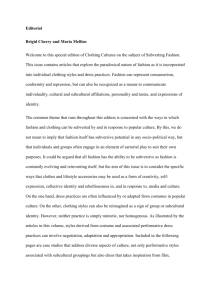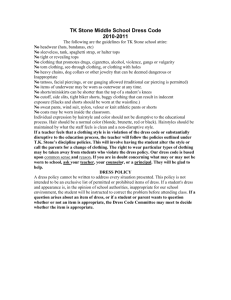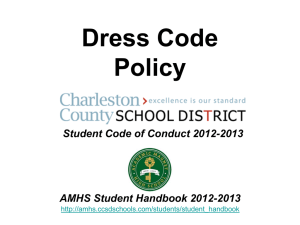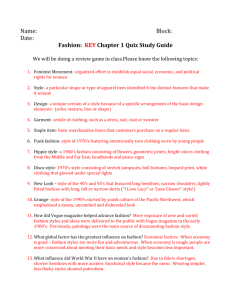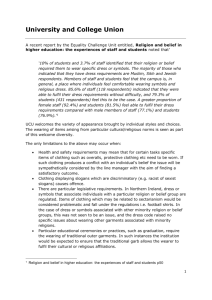Clothing, Identity and the Embodiment of Age
advertisement
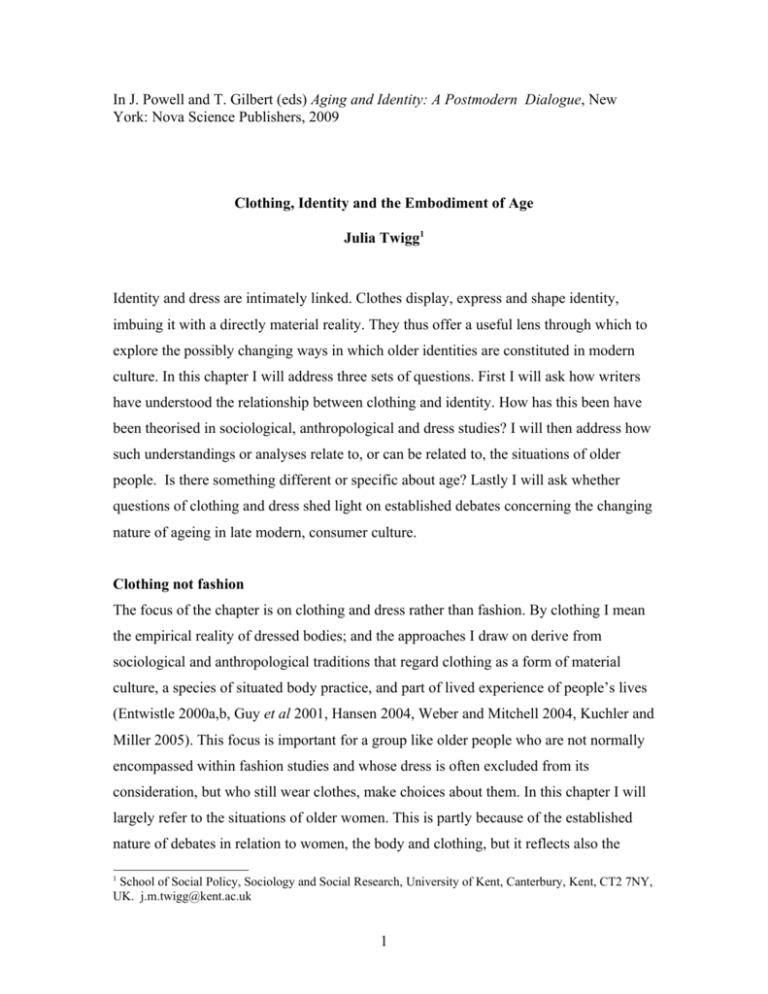
In J. Powell and T. Gilbert (eds) Aging and Identity: A Postmodern Dialogue, New York: Nova Science Publishers, 2009 Clothing, Identity and the Embodiment of Age Julia Twigg1 Identity and dress are intimately linked. Clothes display, express and shape identity, imbuing it with a directly material reality. They thus offer a useful lens through which to explore the possibly changing ways in which older identities are constituted in modern culture. In this chapter I will address three sets of questions. First I will ask how writers have understood the relationship between clothing and identity. How has this been have been theorised in sociological, anthropological and dress studies? I will then address how such understandings or analyses relate to, or can be related to, the situations of older people. Is there something different or specific about age? Lastly I will ask whether questions of clothing and dress shed light on established debates concerning the changing nature of ageing in late modern, consumer culture. Clothing not fashion The focus of the chapter is on clothing and dress rather than fashion. By clothing I mean the empirical reality of dressed bodies; and the approaches I draw on derive from sociological and anthropological traditions that regard clothing as a form of material culture, a species of situated body practice, and part of lived experience of people’s lives (Entwistle 2000a,b, Guy et al 2001, Hansen 2004, Weber and Mitchell 2004, Kuchler and Miller 2005). This focus is important for a group like older people who are not normally encompassed within fashion studies and whose dress is often excluded from its consideration, but who still wear clothes, make choices about them. In this chapter I will largely refer to the situations of older women. This is partly because of the established nature of debates in relation to women, the body and clothing, but it reflects also the 1 School of Social Policy, Sociology and Social Research, University of Kent, Canterbury, Kent, CT2 7NY, UK. j.m.twigg@kent.ac.uk 1 greater cultural involvement of women these areas. I do not, however, want to exclude men, and I will extend the analysis to them where possible. Clothing and identity The link between clothing and identity is a long established theme in dress studies, though one that has been given new impetus by the rise of postmodernism with its emphasis on identity. The link has been understood in a number of ways. The most prominent has been in terms of social class. From the time Veblen (1889) and Simmel (1904) onwards sociologists have explored the way in which clothing operates as part of class identity, with fashions diffusing down the social hierarchy as they are successively adopted and abandoned by elites, and as lower groups take up the style. Competitive class emulation is thus the engine of fashion. Bourdieu (1984) refined the account with analysis of the role of clothing as a marker of class distinction in which dress is an aspect of cultural capital, part of how elites establish, maintain and reproduce positions of power, reinforcing relation of dominance and subordination. More recently the dominance of class in the account of fashion has been challenged. The democratisation of fashion and the rise of street styles, has rendered its dynamic less central (Davis 1992, Crane 2000), with the result that other aspects of identity are increasingly emphasised. Of these, gender has always been the most significant. Indeed theorists like Entwistle (2000a) present fashion as essentially preoccupied with gender. Clothes have long been used to hide sexual difference in its strong biological sense, at the same time to pointing up and signaling it through assumptions concerning gender in clothing codes. Fashion thus helps to reproduce gender as a form of body style, producing a complex interplay between sexed bodies and gendered identities. Davis (1992) and Teeslon (1995) similarly regard the ambivalences of gender as at the heart of fashion. Much of the writing on gender and fashion has been rooted in feminist analysis. Feminists of the second wave tended to be critical of the fashion system and its malignant impact on the lives of women. Fashion was seen as imposing oppressive forms of gender identity, embodying practices designed to objectify and limit women, locking them into defensive and inauthentic forms of presentation, and reinforcing their cultural association with 2 narcissism and triviality. More recently, feminists influenced by postmodernism, have taken a less negative view, recognising the inescapability of matters of style and cultural formation in relation to the body and appearance. They have been willing to see fashion as part of a distinctive women’s culture, an area of pleasure and expressivity that goes beyond the reproduction of patriarchy and capitalism (Wilson 1985, Evans and Thornton 1989). The third major way in which clothing and identity has been theorised is in semiotic terms, whereby clothing is presented as a linguistic code - a means whereby people send messages about themselves - and Barthes’ (1985) gave a celebrated account of the Fashion System in such structuralist terms. But if clothing is a code, it is an inexact one. Empirical work suggests that meanings are not always fixed or shared, with the link between the intention of the wearer and the interpretation of the observer far from straightforward (Feinberg et al 1992). Davis (1992) suggests clothing is indeed a code, but one with what he terms low semanticity; he argues we should regard it as an aesthetic rather than linguistic code, communicating ambiguity and complexity. Like other cultural goods, its meanings are by their nature immanent and hidden, subject to masking, interpretation and uncertainty. Clothing and identity have also been theorised in terms performativity, emphasising its role in processes of self realisation and presentation. Butler’s (1992) work on drag and the performativity of gender has been influential here. Such analyses have the advantage that they capture the dynamic interaction of self, body and dress, acknowledging the embodied nature of clothing as it both expresses identity to the outside world and acts back on and reinforces it for the individual at a directly physical level. Clothed bodies thus become as Craik (1994) suggests ‘tools for self management.’ These accounts reflect the postmodern themes of expressivity, choice and agency (Finkelstein 1991, Polhemus 1994), and they chime well with the way in which fashion is presented within consumption culture in which there is an emphasis on creating a unique and individual version of the self through consumption goods. These aspects of choice and agency in dress – as in other things -are, however, greatly overstated. It is notable in modern society 3 how similar people in fact appear. This is partly because individuals shop in a market that is shaped by mass production and the Fashion System (Fine and Leopold 1993), but it also reflects the truth that the range of people’s self expression is fairly narrow. At least as dominant as agency and choice, are the principles of conformity and order. Wearing the right clothes, the appropriate dress for the occasion, fitting in rather than standing out, are the dominant concerns of most people. As Simmel pointed out, fashion must be understood in terms of the competing desires for social equalization and for individual differentiation, the interplay between the wish to fit in and to stand out, (Simmel 1904/1971), in which, I would suggest, the first is in many ways the more significant. Indeed Clarke and Miller (2002) argue that postmodern fluidity and optionality produce anxiety as much as pleasure and agency, with the wish to choose the right clothes and fear of choosing the wrong dominating many women’s shopping choices. Franklin (xxxx) also notes the irony of how ‘the increasing emphasis on individuality does not encourage us to create uniquely beautiful looks for ourselves’ Lastly, fashion and identity is often theorised in terms of sub group analysis, in which clothing and body styling is seen markers of the boundaries of the group, a means of stabilizing identity and registering belonging (Polhemus 1994, Evans 1997). Such approaches tend to focus on youth culture, street styles, and transgressive, countercultural modes; and they are rarely applied to conventional or dominant groups; though York’s (1988) account of Sloane Ranger and Le Wita’s (1994) of the French haut bourgeoisie are notable exceptions. Age and identity How can these understandings in relation to dress and identity be related to older people? We have noted how clothing is linked to two classic master identities in the sense of gender and class; and other work has traced its connections with ethnicity and sexuality (Rolley 1993, Khan 1993, Holliday 2001, Tulloch 2008). Clothes are indeed, as Breward (2000) notes, one of the ways in which forms of social difference are made visible and concrete. But such understandings have rarely been extended to age. Older people have been excluded from fashion studies, for reasons that reflect the preoccupations of the 4 fashion/ design industry with youth and high style, as well as the gerontophobia of cultural analysts. However, if we can indeed talk of ‘master identities’, then age is surely one of them: how we are perceived, who we socialise with, how we are judged and ordered socially is crucially determined by our age, or our location within an age categorisation. Age remains a key structuring principle in society, despite the claims made for the destabilisation of the life course and the new fluidities of postmodern society. It has not, however, received the attention that other identities or dimensions of difference such as gender, class or race. It is rarely included in the debate on intersectionality (Brewer 1993, Maynard 1994, Anthias 2001, Krekula 2007). In many ways we are in a similar position in relation to age as we were thirty years ago in regard to gender: just as gender used be invisible, part of the taken for granted reality of the world, so age categorisation is currently something so assumed, so naturalised in biology, that we fail to acknowledge its power. If age is indeed a key dimension of difference, how should we conceptualise the role of dress in its constitution? First we should note that it is not sensible to interpret this in terms of sub cultures. As we noted, sub-cultural analysis is focussed on groups who can be regarded as deviant and to some degree oppositional. Though attempts have on occasion be made to interpret age as a form of deviant identity, it remains a strained and ultimately misleading analogy. Older people, though perhaps ‘deviant’ in their marginalisation from the mainstream, are not oppositional in culture; it is not helpful to regard older styles as adopted for counter cultural effect, or to assert a deviant identity. It is better to regard the dress of older people as part of a more general process of Age Ordering. Age ordering in dress is perhaps easiest to see in relation to children, where at least since the Romantic period in the West children have worn distinctive forms of dress that reflect their position in the age order. The degree of this, and its interplay with adult fashion, varies historically and culturally, but clearly there are forms of dress that relate to childhood, and that are seen as appropriate for children to wear. In the past, this was true of older people also, and certain forms of dress were traditionally thought appropriate for 5 older men and women: the long robe, caps and kerchiefs, sober, quiet dress (Lurie 1992). Some of these associations persist today, certainly in relation to longer skirts, covered up arms and necklines, neutral toned down colours, and the avoidance of showy, blatant or sexual styles. Iltanen (2005) reports that designers when asked to select garments appropriate for women in their fifties and sixties chose predominantly dark or muted tones. These self effacing features mark out the dress for older people. However, the story is in fact more complex, and there are other current styles that also have an age association – for example the bright, loose resort wear that characterises the dress of, particularly American, elders. These leisure styles draw on the meanings of being at play, of being no longer constrained by the norms of business dress, with its emphasis on the sober, dark and structured. They are about comfort, with easy cut and integral spandex to allow for expanding figures (Lurie 1992, O’Connor 2005). But at times they suggest a second childhood, with their toddler like shapes and colours, easy clean fabrics; and in doing so point to another future, for these clothes are also common in care settings where there is a pervasive use of jogging bottoms and other forms of babywear. Age ordering has clearly been a feature in the past, but is it still so? Have there been changes in culture that mean that it does not operate in the way that it once did? Certainly the dominant cultural narrative is one in which age ordering is regarded as increasingly irrelevant. In this account there are not clothes for older people as such, just different modes for different life styles. This shift to a destructured, non age ordered market is certainly how the fashion industry likes to present the issue; though this may reflect the wish to avoid negative messages through overt labelling of clothes in age terms. In this interpretation, the bright loose ‘resort’ styles, described above, may simply reflect wider changes in the clothing system in which there has been a marked shift in the last two decades towards leisure wear for all age groups. For many working men, in particular, this is their sole mode of dress. Its adoption by older people can therefore be interpreted as evidence, not of age ordering, but age integration. Crane (2000) however presents a counter interpretation in which she argues that age has replaced class as the engine of change in the fashion system. With the democratisation of 6 fashion in the late twentieth century, class is no longer the key driver. Styles now diffuse down the age hierarchy, as they once did down the class hierarchy. In this account, age ordering is still highly significant, indeed is some senses more so than in the past. What has happened is that the form of the ordering has changed, reconstituted itself. The empirical evidence for Crane’s assertion is thin. Work by Freitas and colleagues (1997), however, does support the view that young people associate out of date clothing with older people. These conflicting accounts of the extent and meaning of age ordering require empirical investigation; and I hope to explore them more fully in the related research project (Twigg 2007, forthcoming). Age ordering also relates to an issue I will take up in the last section of this chapter which concerns the role of consumption in the configuration or reconfiguration of age. Clothing and the body Clothing is closely linked to the body. It forms the vestimentary envelope that contains the body and presents it to the social world. It is the body that makes clothes live; and we cannot understand the field of clothing and age without reference it. Over the last two decades there has been a mass of writing on the body, much of it influenced by postmodern and post structuralist theorising (Turner 1984, Shilling 1993, 2000, Williams and Bendelow 1998, Crossley 2001). Such accounts are frequently underpinned by a radical epistemology in which the body is presented as a discursive construction, knowable only in and through the discourses and practices that inscribe it. Work in this vein tends to emphasise the plasticity of the body, the capacity of individuals and cultures to alter, mould, and reformulate it through cultural practices and through techniques like plastic surgery, implants, technological extensions (Shilling 2004); and this is linked to the postmodern emphasis on fluidity of identity and the malleability of the decentred self. These approaches have, however, been subject to critique. Despite their emphasis on the body, they seem to present an oddly disembodied account in which the physicality of the body, its heavy, sensate corporeality, is lost in a fog of discourse and sign. There is little sense of the body as lived reality, of the ways it might be a generator as well as a receptor of meanings. More recently, there has been a welcome return of interest in real bodies and 7 real embodiment informed by the phenomenological work of Merleau-Ponty and new strands of theorising such as Critical Realism (Williams 1999). These debates have implications for how we understand ageing and identity, for ageing has a fundamentally bodily character. This is not to say that it is not profoundly shaped by social and cultural discourses; but we need to recognise how these operate interactively with physiology. Ultimately as many critics note, aging is not optional. There is a limit to the plasticity of the body. Despite all the efforts of surgery, anti-ageing medicine, cosmetics and exercise, bodies still age and die. We thus need to understand ageing as both a physiological and cultural phenomenon. This has consequences for how we approach identity and dress, for some of the features of age-associated clothing arise from physiological changes. For example, the cut of clothes for older people is looser, designed to accommodate thickening waists and heavier busts (Goldsberry et al 1996). Sizes are often larger, as older people, particularly post menopausal women, tend to gain weight; indeed strenuous dieting in pursuit of a youthful figure is sometimes adopted as a conscious strategy of age resistance, with the current slim ideal acting to valorise a particularly youthful figure in the form of the pre-maternal, adolescent body (Bordo 1993, MacSween 1993) . In terms of colour the toned down palate associated with age does largely seem to be cultural, signalling self effacement and no longer making claims for attention, particularly sexual attention. Colours such as scarlet are commonly described as unsuitable or unflattering for older women, and their condemnation clearly draws in wider ideas of the meaning of scarlet as showy, blatant, sexual. (The adoption of the colour by the Red Hat Society, a group of older women in America, is an example of resistance to the implications of these meanings (Hutchinson et al 2008).) However, there may be some truth in the idea that as skin ages, different colours come to be flattering or unflattering in ways that do not simply reflect cultural stereotypes. There may be some scope here for an independent operation of the body, though heavily mediated by cultural meanings. We noted earlier how dress studies have used the concept of performativity to theorise the link between identity and clothing. Identities certainly need to be understood as 8 embodied processes, experienced and performed at the level of the body. This raises the question of how far older people enact or perform their age through the medium of dress and, more significant, how far they are able to enact different versions through different, perhaps younger, forms of dress. And here I would suggest that once again the physicality of the body comes into play. Youthfulness is not just a product of performance. Adopting youthful styles is not necessarily a route to appearing young, and is sometimes the reverse. Indeed exaggeratedly youthful styles can point up age, exposing the disjuncture between the expectations of the dress and the aged body that wears it. Featherstone and Hepworth (1991) argue in their account of the Mask of Ageing that the experience of age in postmodernity is one in which people are increasingly unable to perform their identities in ways consonant with the expectations of consumer society. The mask of ageing is an old conceit: what is new is the character of consumption society and the demands it presents. Consumption culture and the reconfiguration of old age This brings me to the third section of the chapter, which concerns the ways in which questions around dress and identity relate to established debates within gerontology in relation to consumption culture. There has been much work recently on the role of consumption in reconfiguration of age, associated in particular with the rise of the Third Age as a new intermediate social space (Featherstone and Hepworth 1991, Phillipson 1998, Gilliard and Higgs 2000). By this account later years should be understood culturally, not as old age, but as an extension of late middle age. Oberg and Tornstam (2001) link this to wider set of social processes whereby individuals in modern societies are less age differentiated across the life span. Midlife becomes an extended plateau reaching higher and higher up the age span. Biggs and colleagues (2008) found that the current ‘young old’ identify closely with the cohorts that are younger and not with those older than them, and they interpret this as evidence for a greater integration with mainstream culture, though they are not in fact able to address whether this might also have been true of earlier generations, reflecting a recurring desire of young older people to ‘outdefine’ themselves from the negatively perceived group (Hurd 1999). Such arguments are sometimes allied with a cohort analysis, in which the current generation of 9 late middle age/early old age - typified somewhat loosely, since the demographics vary between countries, as the baby boomer generation - are regarded as occupying a strategic generational position, acting as the vector of social change through their earlier and pioneering involvement in youth, and later, consumer culture (Gilleard and Higgs 2000). There are two contrasting interpretations, or rather evaluations, of these developments. The first is broadly favourable. By this account, consumption forms a basis for social integration and is a source of pleasure and identity fashioning, so its extension to later years acts to integrate older people into the mainstream. In relation to clothing and dress, it means the end of the old culture of age ordering, of self effacement, and drab and frumpy dress: there is no reason why older people should not wear the same clothes, shop at the same fashion conscious shops as younger people. For women in particular it offers liberation from what is a very negative set of messages around sexuality, appearance and self assertion, policed by a heavily moralistic language. As we noted earlier systematic evidence for the disappearance of age ordering has yet to be gathered and evaluated, however, there are reasons to think that there has been cultural changes in this regard. The development of consumer culture also means extending to older people the same access to self expression and identity formation that is enjoyed – it is asserted - by young. Muphy and Longino (1997) argue that the transformations of postmodernity have indeed produced a shift toward greater freedom in the self construction in age, an erosion of the constraints of cultural and material necessity. Fluidity, playfulness, optionality are thus extended to older people also. For women, in particular, consumption culture offers the possibility of continuity with an earlier self in the form of the women’s culture of pleasure in dress: there is no reason why older women should be exiled from this area of aesthetic pleasure. This broadly celebrationist account has been subject to critique. It applies only to the well off, since integration through consumption requires income. Though there are many older people with high disposable incomes, there are many without; and the uncertainly of future pension provision means that latter group are likely to grow, undermining the 10 celebrationist trajectory of future old age. Phillipson is also critical of the impact of these discursive structures on the status of older people more generally; the deinstitutionalisation of the life course and the destabilisation of traditional sources of identity he argues threaten to undermine the cultural and ethical basis of the liberal welfare state, and in doing so expose the less affluent to unprecedented economic and existential hazard (Phillipson 1998, Phillipson and Biggs 1998). The postmodern dream of ageing is also predicated on good health. To sustain this dream the body needs to be able to bear the kinds of identity construction that extended middle age offers. But illness and disability disturb this basis; the pleasures of dress are likely to ebb away as this happens. Critiques also arise from the sense that exposure to consumption culture with its heavy emphasis on appearance and presentation sets up a set of demands in terms of which older people can only fail. Consumption culture is profoundly youth oriented. But if such youthful identities become increasingly impossible to perform, greater engagement with the sphere of appearance may only present occasions for failure, undermining confidence and well being. The spread of consumption values and expectations may thus be oppressive rather than life enhancing. This is particularly so for women if we accept Sontag’s (1978) account of the double standard in ageing whereby women suffer disproportionably from the valuation of them in terms of their appearance, in contrast to men who are able to draw on more continuing sources of esteem. Against this however we should note recent Scandinavian work (Oberg and Tornstam 1999, Daatland 2007, 2008) that suggests that older women are in fact happier with their bodies and appearance than younger ones; and that they have similar and even higher levels of satisfaction than older men, evening up what is at earlier ages a persistent difference in relation to satisfaction and esteem. This is a paradoxical finding in the context to the wider cultural evaluation of bodies. One way we can understand this is in terms the increasingly heavy pressure placed on younger women to in regard to the presentation and disciplining of their bodies, with familiar malignant consequences in terms of eating disorders and obsessive dissatisfaction with looks (Bordo 1993, 11 MacSween 1993) . Older women may be more satisfied because they are no longer subject to these stringent norms of femininity. Such work however raises questions about how liberating or enhancing the spread of consumption culture will in fact be for older women. Are we just spreading the scope of anxiety and sense of performance failure? Krekula (2007) suggests another way we can understand the apparent paradox. She notes the failure of mainstream gender studies and social gerontology to discuss older women as subjects in theories as opposed to objects in research, with the result that work on older women is marked by a persistent Othering that fails to engage with the lived subjectivity of older women. Far from endorsing Sontag’s simple account in terms of the double standard, her empirical work among women over 75 shows the complexity and ambivalence of women’s evaluation of their bodies. The women did use negative words to describe changes to their bodies such as wrinkles and slackness of figure, but at the same time they spoke with pride about their ‘dressed up body’ which was the focus of pleasure, esteem and adornment. And Krekula (2007) specifically mentions the pride women felt when dressed in ‘beautiful clothes’. Krekula suggests that it is fruitful to distinguish conceptually between the physical body, which pertains to wrinkles and loss of appearance and the body as an embodied identity claim: ‘it is possible to understand how these women describe their bodies with pride when they convey identity claims, and at the same time, talk about bodily changes with negative words’ (2007, p166). Rather than being contradictory these express different aspects of the body. Lastly there is the question of transcendence. Consumer culture is essentially materialistic: it is about the concrete, the material, the here and now of acquisition and possession. It leads us to regard our bodies as sites for intervention, encouraging us to be more focussed on and in our bodies. But old age may properly be a time of transcendence and disengagement from the physical, a time to leave the body behind in the pursuit of other aspects of the self. Gerontology has tended to fight shy of such assertions, partly as a result of the declining salience of religion in western culture (or at least in European culture: American gerontologists have been more willing to address these areas (Cole 1992, Polivka 2000)); but partly also from a proper sense that such language of 12 transcendence in old age may be an imposition on older people of cultural values in which they have no personal interest. There are parallels here with the earlier discrediting of disengagement theory (Phillipson and Walker 1986). But there may in fact be good reasons to embrace transcendence in later years. We know from work on chronic illness and pain that the capacity to separate the self from the body is a key element enabling people to manage bodily failure (Williams and Bendelow 1998), so that bodily transcendence may be a fruitful strategy to adopt in the face of the depredations and changes of old age. In relation to clothing and appearance, why invest time, money and the self in an area where returns are likely to be diminishing and engagement only discouraging? Queen Elizabeth I is often made subject to implicit criticism for her banishment of all mirrors from her palaces as she grew old, but perhaps her strategy was a wise one. Conclusion Clothes offer a field in which we can explore the cultural constitution of age. Clothes are cultural artefacts, embedded in current and historical sets of meanings, shaped by social and economic forces, reflecting current social and cultural concerns. Among these sets of meanings are assumptions about the nature of age and its role within the social order. As we have seen clothes have historically been age ordered, reflecting embedded assumptions about age and its role in society. Age has always been a one of the key structuring principles, and we should not be surprised to find it reflected at the bodily level in the clothes that people wear. Indeed, part of the wider role of clothes, as we noted, is to render social difference concrete and visible. But these traditional forms of age ordering are increasingly under pressure. The democratisation of fashion and the growth of involvement of older people in consumption are in the process of changing the nature of age ordering in dress in ways that point to wider shifts in the experience and understanding of later years. We now have what appears to be an extended plateau of late middle years, broken only by the onset of serious disability or illness, in which there is cultural continuity with earlier stages and cohorts, cemented by the common field of consumption. Dress is part of this. 13 Clothing also enables us to address questions of the plasticity of the body and identity. Though clothes need to be seen as cultural artefacts, they operate in conjunction with and in response to the body, so that their materiality needs to reflect the materiality of the body. In the case of older bodies this means responding to changes that occur as people age, so that the nature of clothing for older people is to some degree determined, or at least influenced, by such changes. Although we rightly focus on the ways in which the body and ageing are both culturally defined, constituted in and through discourses, embedded in cultural meanings, we need to retain a sense also of their physicality and the interplay that occurs around this. Clothes can indeed be a means for individuals to present themselves ways that are less compromised by the negative stereotypes of wider culture, embodied in frumpy, drab, self effacing ‘older person’s’ dress. Clothes have particular significance here because of their capacity to stand alone as artefacts, separate from the individual and their body, though at the same time acting as an intermediary between the body and its public presentation. Unlike the face or hair, or other aspects of the bodily appearance, they are wholly cultural productions, and they can literally be put on or off. But as we noted, this capacity to transform and redefine is limited. Clothes operate in conjunction with the body; there is an interplay between the two. An old body in youthful dress is not transformed but exaggerated. Adopting youthful styles, or at least avoiding age associated ones, can help to present the self in a less clearly age defined manner. All of this supports the view that identities are to some degree optional, but the extent of this has been over emphasised. The postmodern dream of fluidity and self fashioning has been exaggerated, certainly in regard to old age and the role that appearance and dress play in its constitution. As many critics have commented, old age is not optional even in the land of postmodernity. 14 References Anthias, (2001) ‘The concept of “social division” and theorising social stratification: looking at ethnicity and class’, Sociology, 35, 4, 835-54 Barthes, R. (1985) The Fashion System, London: Cape Bourdieu, P. (1984) Distinction: A Social Critique of the Judgement of Taste, London: Routledge Kegan Paul Biggs, S, Phillipson, C., Leach, R. and Money, A-M (2008*) The mature imagination and consumption strategies: age and generation in the development of a United Kingdom baby boomer identity, International Journal of Ageing and Later Life, Bordo. S. (1993) Unbearable Weight: Feminism, Western Culture and the Body, Berkeley: University of California Press Brewer, R.M. (1993) ‘Theorizing race, class and gender: the new scholarship of Black feminist intellectuals and Black women’s labor’ in S. M. James and A.P.A Busia (eds) Theorizing Black Feminisms: the Visionary Pragmatism of Black Women London: Routledge Breward, C. (2000) ‘Cultures, identities, histories: fashioning a cultural approach to dress’, in N.White and I.Griffiths (eds) The Fashion Business: Theory, Practice, Image, Oxford: Berg Butler, J. P. (1993) Bodies that Matter: On the Discursive Limits of “Sex”’, London, Routledge. Clarke, A. and Miller, D. (2002) ‘Fashion and anxiety’, Fashion Theory, 6, 2, 191-214 Cole, T. C. (1992) The Journey of Life: A Cultural History of Aging in America, Cambridge: Cambridge University Press Craik, J. (1994) The Face of Fashion: Cultural Studies in Fashion, London: Routledge Crane, D. (2000) Fashion and Its Social Agendas: Class, Gender and Identity in Clothing, Chicago: University of Chicago Press Crossley, N. (2001) The Social Body: Habit, Identity and Desire, London: Sage Davis, F (1992) Fashion, Culture and Identity, Chicago: University of Chicago Press 15 Daatland, S.O. (2007) ‘Age identifications’, in R. Fernández-Ballesteros (ed), Geropsychology: European perspectives for an aging world Göttingen: Hogrefe & Huber, 31-48 Daatland, S. O. (2008) ‘Self perceived age and ageing: are women less defensive than men’, paper given at 60th Meeting of Gerontological Society of America, San Francisco Entwistle, J. (2000a) The Fashioned Body: Fashion, Dress and Modern Social Theory, Cambridge: Polity Entwistle, J (2000b) ‘Fashion and the fleshly body: dress as embodies practice’ Fashion Theory: The Journal of Dress, Body and Culture, 4, 3, 323-48 Evans, C. (1997) ‘Street style, subculture and subversion’ Costume, 31, 105-10 Evans, C. and Thornton, M. (1989) Women and Fashion: A New Look, London: Quartet Featherstone, M. and Hepworth, M (1991) ‘The mask of ageing and the postmodern life course’ in M.Featherstone, M. Hepworth and B. S.Turner (eds) The Body: Social Process and Cultural Theory, London, Sage. Feinberg, R. A, Matero, L. and Burroughs,W.J. (1992) Clothing and social identity’, Clothing and Textiles Research Journal, 11, 1, 18-23 Fine, B. and Leopold, E (1993) The World of Consumption, London: Routledge Finkelstein, J. (1991) The Fashioned Self, Cambridge: Polity Press Franklin Freitas, A., Kaiser, S, Hall, C., Kim, J-W., and Hammidid, T. (1997) ‘Appearance management as border construction: least favourite clothing, group distancing, and identity…Not’, Sociological Inquiry, 67, 3, 323-335 Gilleard, C. and Higgs, P (2000) Cultures of Ageing: Self, Citizen and the Body, London: Prentice Hall Goldsberry, E., Shim, S., Reich, N., (1996) ‘Women 55years and older: Part I Current body measurements as contrasted to the PS 42-70 data’ Clothing and Textiles Research Journal, 14, 2, 108-120 Guy, A., Green, E. and Banim, M. (eds) (2001) Through the Wardrobe: Women’s Relationships with Their Clothes, Oxford: Berg 16 Hansen, K.T. (2004) The world in dress: anthropological perspectives on clothing, fashion and culture’, Annual Review of Anthropology, 33, 369-92 Holliday, R. (2001) ‘Fashioning the queer self’ in J. Entwhistle and E. Wilson (eds) Body Dressing, Oxford: Berg Hurd, L.C. (1999) “We’re not young”: Older women’s negotiation of aging’, Journal of Aging Studies, 13, 4, 419-39 Hutchinson, S.L., Yarnal, C.M., Staffordson, J. and Kerstter, D.H. (2008) ‘Beyond fun and friendship: The Red Hat Society as a coping resource for older women,’ Ageing & Society, 28, ** Iltanen, S. (2005) ‘Constructing the image of a user through design’, paper delivered at British Society for Gerontology Conference, University of Keele Khan, N. (1993) ‘Asian women’s dress: from burqah to bloggs’ in in J.Ash and E.Wilson (eds) Chic Thrills, Berkeley: University of California Press Krekula, C. (2007) ‘The intersection of age and gender: reworking gender theory and social gerontology’, Current Sociology, 55, 155-171. Kuchler, S and Miller, D. (eds) (2005) Clothing as Material Culture, Oxford: Berg Le Wita, (1994) French Bourgeois Culture, trs J.A.Underwood, Cambridge: Cambridge University Press Lurie, A. (1992) The Language of Clothes, London: Bloomsbury MacSween, M. (1993) Anorexic Bodies: A Feminist and Sociological Perspective on Anorexia Nervosa, London: Routledge Maynard, M. (1994) ‘”Race”, gender and the concept of “difference” in feminist thought’ pp9-25 in H.Afshar and and M.Maynard (eds) The Dynamics of ‘Race’ and Gender: Some Feminist Interventions, London: Taylor and Francis Murphy, J and Longino, C. (1997) ‘Towards a postmodern understanding of ageing and identity’, Journal of Aging and Identity, 2, 2, 81-9 Oberg, P. and Tornstam, L. (1999) ‘Body images among men and women of different ages,’ Ageing & Society, 19, 629-644 Oberg, P. and Tornstam, L. (2001) ‘Youthfulness and fitness – identity ideals for all ages? ‘ Journal of Ageing and Identity, 6, 1, 15-29 17 O’Connor, K (2005) ‘The other half: the material culture of new fibres’, in Kuchler, S and Miller, D. (eds) (2005) Clothing as Material Culture, Oxford: Berg Phillipson, C. (1998) Reconstructing Old Age: New Agendas in Social Theory and Practice, London: Sage Phillipson, C. and Walker, A. (eds) (1986) Ageing and Social Policy: A Critical Assessment, Aldershot: Gower Phillipson, C. and Biggs, S. (1998) ‘Modernity and identity: themes and perspectives in the study of older adults’, Journal of Aging and Identity, 3, 1, 11-23 Polhemus, T. (1994) Streetstyle: From Sidewalk to Catwalk, London: Thames and Hudson Polivka, L. (2000) ‘Postmodern aging and the loss of meaning,’ Journal of Aging and Identity, 5, 4, 225-235 Rolley, K. (1993) ‘Love desire and the pursuit of the whole: dress and the lesbian couple’ in J.Ash and E.Wilson (eds) Chic Thrills, Berkeley: University of California Press Shilling, C. (1993) The Body and Social Theory, London: Sage Shilling, C. (2004) The Body in Culture, Technology and Society, London: Sage Simmel, G (1904/ 1971) ‘Fashion’, On Individuality and Social Forms: Selected Writings, trs D.C.Levine, Chicago: University of Chicago Press Sontag, S. (1979) ’The double standard of ageing’ in V. Carver and P Liddiard (eds) An Ageing Population, New York: Touchstone Tseelon, E. (1995) The Masque of Femininity, London: Sage Tulloch, C. (2008 not seen) The Birth of Cool: Style Narratives of the African Diaspora, Oxford: Berg Turner, B S (1984) The Body and Society: Explorations in Social Theory, Oxford: Blackwell Twigg, J (2007) ‘Clothing, age and the body: a critical review’, Ageing & Society, 27, 285-305 Twigg, J. (forthcoming) ESRC award Clothing, the body and age: www.esrcsocietytoday.ac.uk Veblen, T. (1899/1953) The Theory of the Leisure Class: An Economic Study of Institutions, New York: Mentor 18 Weber, S., and Mitchell, C. (eds) (2004) Not Just Any Dress: Narratives of Memory, Body and Identity, New York: Lang Williams, S.J. (1999) ‘Is anybody there? Critical realism, chronic illness and the disability debate’, Sociology of Health and Illness, 21, 6, 797-819 Williams, S.J. and Bendelow, G. (1998) The Lived Body: Sociological Themes, Embodied Issues, London: Routledge Wilson, E. (1985) Adorned in Dreams: Fashion and Modernity, London: Virago York, P. (1980) Style Wars, London: Sidgwick & Jackson 19

